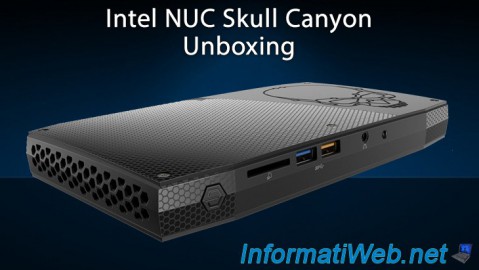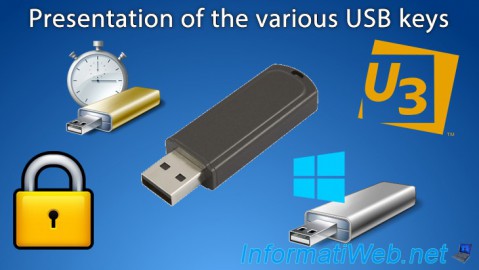Create your own configuration (Case, CPU, RAM, GPU, ...)
- Articles
- 28 January 2015 at 17:05 UTC
-

- 3/7
4. Choose your motherboard
Choosing your motherboard is very important because everything goes through it. The hard drives, RAM sticks, the processor, graphics cards, ...
If you want to recover some components of your old tower, know that many things were changed since the time of IDE hard drives :
- IDE ports for hard drives have been replaced by SATA ports (smaller, faster and easier to use). But you can add IDE hard drives with a "PCI controller card with two internal IDE ports".
In fact, no need to rack your brains with jumpers to use "master / slave" configurations. With SATA ports, you connect the SATA cable between the hard drive and the motherboard and it's over. (Don't forget to plug the power cable of the hard drive).
- the AGP slot for the graphics card has been replaced by one or more PCI Express ports (depending on motherboards models).
- the CPU socket is no longer the 775 socket but 1155, 1150, 2011, ...
- RAM sticks are no longer SDRAM but DDR (DDR2, DDR3, ...)
- the "serial" port has disappeared. But, you can add one with a "PCI controller card with 2 RS-232 (DB-9) ports".
- the "parallel" port has disappeared. But, you can add one with a "PCI controller card with 1 Parallel Port".
As mentioned in the introduction, there is different product lines available : the high range (usually more expensive than the others but more efficient and more complete), the middle range and low range.
For motherboards, we recommend these brands :
- high quality : Asus (very good brand, very good quality, ...)
- middle range and low range : Asrock, Gigabyte ...
Of course, these brands also provide high-end motherboards, and low-end but Asus is known for providing professional motherboard (high-end). And our experience allows us to confirm this statement.
For our own professional configuration, we chose the motherboard "ASUS Z97-PRO WI-FI AC" because she has several interesting features from Asus :
- The "CrashFree BIOS 3" feature : allows you to restore the BIOS even if an error occurs during the update (flash) of it. Without this feature, an error that would occur during the BIOS flash, render the motherboard permanently inoperable.
- The "BIOS Flashback" feature: allows you to update your motherboard BIOS without using a processor. So, you can try to support your new processor by making a BIOS update using this feature.
- The "MemOK!" feature : To automatically change the BIOS settings to make your RAM sticks compatible with your motherboard. The success rate is not 100%, but in general, it works. This feature is useful when the red LED lights up next to this button. In this case, the supply of your computer starts but the screen will not display anything because of the incompatibility detected with your RAM sticks.
- The "ASUS Q-Code" feature : that displays the "POST" codes on the small "screen" at the bottom of this motherboard. When your computer doesn't start, simply refer to this code to find the cause of the problem.
- The "ASUS Q-LED" : which allows you to know what is the component that has a problem, due to red LEDs that light up for a particular component that has a problem. (CPU, DRAM, VGA, Boot Device LED)
- Etc.
First, check that the desired motherboard is compatible with your processor and your RAM sticks :
- For the processor :
1) Choose a processor manufacturer : Intel or AMD
2) Next, check the socket number (usually 1150, 1155, 1156, 2011, ...) and check the compatibility of your processor on the motherboard manufacturer's website. Example : For Asus, select your motherboard, then go to : Support -> CPU Support.
- For RAM sticks : Check the version (DDR2, DDR3, DDR4, ...), frequency (1333, ..., 3200 MHz) and the maximum usable amount (eg 32 GB) by going to the same website. For Asus, this information can be found in the features of the motherboard.
Connectors available on the motherboard must also orient yourself to a particular model :
- the presence of SATA 6 Gb/s (SATA 3) connectors for SSD or hard drives designed for this new "SATA 6Gb/s" standard. SDD and 6Gb/s HDD are backwards compatible SATA 3Gb/s but you get better performance by plugging them on 6Gb/s (SATA 3) SATA ports. Ensure that the SATA cable used is also planned for this "SATA 6Gb/s (SATA 3)" standard.
- the number of SATA 3Gb/s (SATA 2) and / or SATA 6 Gb / s (SATA 3) connectors : for hard drives and SSD.
- the number of PCI Express ports: According to the PCI Express cards (in general : graphics cards) that you want to use, you should use a particular model.
For example : The motherboard "ASUS Z97-PRO WI-FI AC" has 2 ports "PCI-Express 3.0 x16" to allow you to make a SLI (use multiple graphics cards simultaneously) if you wish. - the number of PCI slots : According to PCI cards that you want to use, you should use a particular model.
PCI slots are used to connect lot of things and are used to add almost anything :- IDE ports for old hard drives and CD / DVD drives
- SATA ports for new SATA hard drives (or for SSD)
- USB ports
- internal USB 3.0 ports (for internal USB 3.0 cables from the front of the tower or for certain USB 3.0 internal card readers)
- Firewire ports
- Serial ports
- Parallel ports
- eSATA ports
- Etc.
- the presence and the number of internal USB 3.0 ports (We talk about the internal USB 3.0 connector, not the USB 3.0 external connector that everyone knows) : Allows you to connect the internal USB 3.0 cable of the case (if any), one of an USB 3.0 card reader, ...
- the number of internal USB 2.0 ports (For the same reason as for USB 3.0 ports): Allows you to connect the internal USB 2.0 cable of the case (as a general rule, there is one for the USB 2.0 ports of the front panel ) , one of a USB 2.0 card reader, ...
- the number of USB 2.0 and 3.0 External ports: It depends if you are using USB 3.0 devices or not.
- the presence of SATA Express ports : New standard allowing a theoretical speed of 10 Gb /s using two PCIE 2.0 lines. These ports are backward compatible SATA 6 Gb/s (SATA 3).
- the number of 3 or 4-pin connectors for fans. It's possible to adjust the speed of a fan connected to a 4-pin connector, but not those in 3-pin connectors. That said, a fan with a 3-pin connector can be plugged into a 4-pin connector (respecting the polarizing slot).
5. Choose your processor (CPU)
To choose a processor, you must choose between the two famous manufacturers :
- Intel
- AMD
In general rule, Intel processors are the most used and best known than AMD processors but each has his favorite brand. I personally prefer Intel but it's just because I've always had Intel CPUs and I am totally satisfied. By mounting computers in a computer store for 3 months, I noticed that computers with an AMD processor had more time for the startup screen is displayed (which is a problem when troubleshooting the computer) . But, at the performance level, maybe that AMD processors are same performance as Intel. I never took the time to compare them.
5.1. Intel
At the moment, the most popular Intel processors :
- Intel Core i3 : low-range. Enough to make office
- Intel Core i5 : mid-range (even high-range at a correct price)
- Intel Core i7 : high-range (but the price is higher)
Now, you should know that these three processor families are available in different versions. Warning : these three processor families not using all the same sockets. For example : The new "Intel Core i5-4460" uses a 1150 socket when an older model as the "Intel Core i5-3470" used a 1155 socket.
First, you can know the chipsets compatible with your processor, by going on the sheet of the Intel CPU and then clicking "Compatible Products" in the left menu. Then, also check on the motherboard manufacturer's website to be sure that the processor is also supported on their side (theoretically "yes" but we are never be too careful).
5.2. AMD
Not being an expert for the AMD brand, here is some information based on tests performed by hardware testing specialists :
- low-range : AMD A4-4000 (3.0 GHz)
- middle-range : AMD FX 4350 Black Edition (4.2 GHz) and AMD FX 6350 Black Edition (3.9 GHz) (4,2 GHz in turbo mode)
- high-range : AMD FX 8350 Black Edition (4.0 GHz)
Informations base on the test : "Choose your processor, processors comparison".
Share this tutorial
To see also
-

Articles 3/7/2017
Intel NUC Skull Canyon - Unboxing
-

Articles 1/21/2017
Presentation of the various USB keys
-

Articles 2/17/2013
UBCD - Presentation of the live CD features
-

Articles 2/12/2013
Why not install several AV simultaneously


No comment